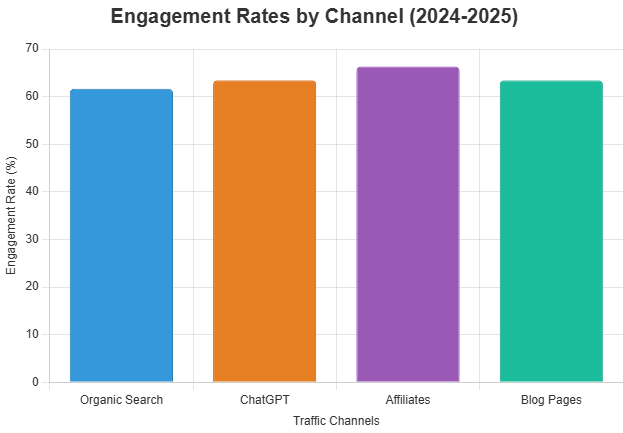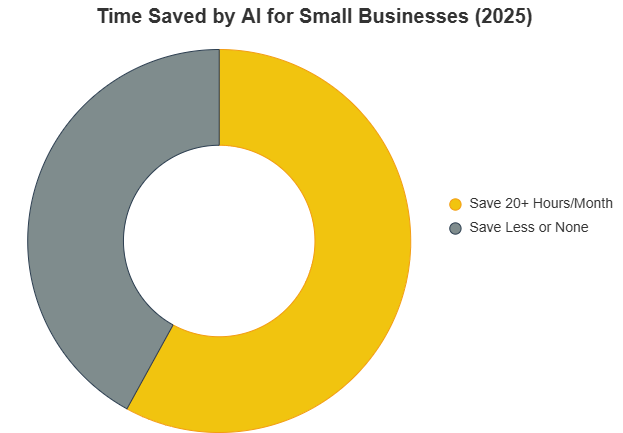
A Guide To The Benefits and Implementation of Organic Search Engine Optimisation (SEO).
The Enduring Power of Organic SEO: Benefits and Implementation Guide for 2025
In an era where AI-powered search tools like ChatGPT are making headlines and Google is constantly tweaking its algorithms, one thing remains clear: organic SEO is still the king of digital visibility. According to recent data from BrightEdge, AI search referrals account for less than 1% of total traffic, while organic search continues to drive the majority of conversions and high-quality visits. Even as ChatGPT traffic shows slightly higher engagement rates (63.42% vs. 61.64% for organic search), the volume from traditional organic channels far outpaces AI, making it essential for sustainable growth.

But why bet on organic SEO in 2025? And how can you implement it effectively without a massive budget? Drawing from insights across industry reports, expert advice, and real-world benchmarks, this guide explores the key benefits of organic SEO and provides a step-by-step implementation plan to help your business thrive.
Why Organic SEO Still Reigns Supreme: Key Benefits
Organic SEO—optimizing your website to rank naturally in search engine results pages (SERPs)—offers advantages that paid ads and emerging AI tools simply can’t match. Here’s why it’s worth your investment:
1. Cost-Effective, Long-Term Traffic Growth
Unlike paid search, which requires ongoing budgets, organic SEO delivers compounding returns. Once your content ranks, it can attract traffic for years with minimal maintenance. Data from Conductor’s 2024 benchmarks shows that organic search accounts for the bulk of website traffic across industries, with non-branded searches (users discovering your brand for the first time) often driving 60-70% of visits in sectors like retail and hospitality.
A study from Search Engine Land reinforces this: AI search is growing rapidly (some platforms with triple-digit monthly gains), but it funnels less than 1% of referrals. Organic search, meanwhile, dominates with higher volumes and better conversion rates. For small businesses, this means focusing on organic can save thousands—AI users report saving $500-$2,000 monthly by automating tasks, but organic strategies amplify those savings by reducing ad dependency.
2. Builds Credibility and Authority
Ranking organically signals trust to both users and search engines. Google’s E-E-A-T (Experience, Expertise, Authoritativeness, Trustworthiness) framework rewards sites with genuine authority, often through backlinks, reviews, and local citations. Siege Media’s engagement data highlights that organic traffic is highly qualified, with users spending more time on-site compared to some AI referrals.
Local SEO, in particular, shines here. Service-area businesses (SABs) without physical storefronts can leverage Google Business Profiles (GBP) to appear in local searches, building authority through reviews and community engagement. As per Thryv’s insights, 99.9% of customers read reviews before buying, and businesses with 20-99 reviews earn 59% more trust. Organic strategies like partnering with local businesses for backlinks or co-content can boost this without ads.
3. Superior Engagement and Conversions
While ChatGPT traffic edges out organic in engagement (1.73% higher on average), organic still drives more overall traffic and revenue. Siege Media’s analysis shows organic at 61.64% engagement, up 4.71% year-over-year, while ChatGPT dipped 11.43%. Channels like affiliates and blog pages (both around 66%) underscore how organic content fosters deeper interactions.
Holistic approaches combining organic and paid (as per iQuanti’s webinar) yield superior ROI. Organic builds the foundation, with paid accelerating visibility—yet organic often outperforms in long-term conversions. Benchmarks from Conductor show industries like finance seeing 500K+ monthly impressions from non-branded organic alone.
4. Resilience to Algorithm Changes and Tool Disruptions
Google’s recent disabling of the &num=100 parameter (allowing 100 results per page) disrupted rank trackers, causing desktop impression drops. This highlights organic SEO’s need for adaptability but also its stability—tools adapt, but strong organic foundations endure. Site migrations, per SEJ’s Ask an SEO, can cause 30% drops if mishandled, but recovery strategies ensure long-term resilience.
AI’s low referral impact (less than 1%) means organic remains critical amid rising AI adoption. As Jim Yu from BrightEdge states, “growth and quality are two different things”—organic delivers both.
How to Implement Organic SEO: A Step-by-Step Guide
Ready to harness these benefits? Follow this 8-step framework, inspired by Moz’s cheatsheet and supplemented with recovery tips from SEJ experts. Aim for a holistic approach, integrating organic with minimal paid for maximum ROI.
Step 1: Conduct Keyword Research and SERP Analysis
Start with tools like SEMrush or Ahrefs to identify high-value keywords. Focus on branded (your company name) vs. non-branded (general queries) based on benchmarks—e.g., retail sees 60% non-branded traffic. Analyze SERPs for competitors, rich results (like featured snippets, prevalent in 20-30% of queries per Conductor), and user intent.
Tip: Use AI for initial research (Thryv reports 58% save 20+ hours/month), but refine manually for accuracy.

Step 2: Optimize On-Page Elements
Craft compelling title tags, meta descriptions, and headers with target keywords. Ensure content answers user queries deeply—Google favours E-E-A-T. For e-commerce, enhance product pages with reviews and schema markup.
From Moz: Prioritize mobile-friendly design and fast load times. Benchmarks show pages with rich results (e.g., images, videos) boost visibility by 375%.
Step 3: Fix Technical SEO Issues
Run audits with Screaming Frog or Sitebulb to check redirects, broken links, and Core Web Vitals. Post-migration drops (30% common, per SEJ) often stem from missing 301s or no-index tags—fix these to recover in 4-12 weeks.
Tip: Submit updated sitemaps to GSC and monitor for crawl errors. Address GA4 vs. GSC discrepancies (e.g., cookies blocking GA4 sessions) by verifying setups.
Step 4: Build High-Quality Content
Create evergreen content like blogs and guides. Invite guest posts (from SEJ’s recovery tips) and use AI for drafts (Thryv: 70% see AI as essential). Focus on local authority—partner for co-content, as in SEJ’s local SEO guide.
Benchmarks: Aim for 500K+ impressions in competitive industries by targeting non-branded terms.
Step 5: Focus on Off-Page SEO and Link-Building
Earn backlinks through digital PR and outreach. Fifteen’s role emphasizes securing high-DA links to boost authority—aim for 150+ as in my consultancy work.
Local tactics: Engage communities for citations, per Thryv’s review strategies.
Step 6: Implement CRO for Conversions
Turn traffic into revenue with Moz’s CRO checklist: A/B test CTAs, optimize user journeys. Engagement data shows affiliates at 66%—apply similar tactics to organic pages.
Step 7: Monitor and Measure Holistically
Use GA4 for sessions, GSC for clicks—discrepancies (GA4 often higher due to bots/UTMs) are normal. Track benchmarks: Organic dominates referrals (AI <1%). iQuanti’s attribution models help allocate budgets.
Tools: SEMrush for trends, GA4 for engagement (up 4.71% YoY).
Step 8: Adapt to Changes and Iterate
Google’s &num=100 change caused impression drops—adapt by focusing on quality over quantity. Monitor AI trends (ChatGPT’s high engagement but low volume) and refine strategies quarterly.
Overcoming Common Challenges
– Migrations: Follow SEJ’s guide—crawl pre/post, fix redirects, recover in weeks.
– AI Impact: Low referrals mean organic focus; use AI for efficiency, not replacement.
– Data Discrepancies: Cross-verify GA4/GSC; bots or UTMs inflate GA4—filter accordingly.
– Algorithm Shifts: Stay updated; holistic (organic + paid) buffers changes.
Conclusion: Invest in Organic SEO for Lasting Success
In 2025, organic SEO isn’t just viable—it’s indispensable. With AI referrals lagging and organic driving 61.64% engagement, businesses that prioritize it will outpace competitors. Start with keyword research, build authority through content and links, and measure relentlessly. Whether you’re a small business using AI tools or an enterprise scaling holistically, the rewards—sustainable traffic, trust, and ROI—are worth it.
Ready to boost your visibility by 375%? Get in touch with us at SEO 123 and we can help you achieve your SEO goals.
Get Organic SEO Services from SEO 123
SEO 123 Digital Marketing Agency | Web Design | Content Marketers
SEO 123 is recognized as a leading Organic SEO Agency and Web Design Company, combining deep expertise with forward-thinking search engine optimization strategies to yield successful online marketing outcomes. Whether you’re looking for personalized Organic SEO Website Design Services, specialized Ecommerce SEO Agency expertise, or comprehensive Digital Marketing Agency support, our detailed performance analytics ensure you see the full scope of value we provide.
Reach out today to enhance your Organic Google search rankings, boost website traffic, and maximize conversions, all backed by accurate, data-driven approaches!
Frequently Asked Questions (FAQs) – The Benefits and Implementation of Organic Search Engine Optimisation (SEO).
What is organic SEO?
Organic SEO is the process of improving your website’s visibility in unpaid (organic) search results through content optimization, technical improvements, and link building — without relying on paid ads.
Why is organic SEO important for businesses?
Organic SEO builds long-term visibility, trust, and credibility. Unlike paid ads, which stop driving traffic once the budget ends, organic rankings can deliver consistent, high-quality leads for months or years.
What are the main benefits of organic SEO?
The key benefits include sustainable traffic growth, better user experience, higher conversion rates, and improved brand authority. It also provides a stronger ROI compared to most paid marketing strategies.
How does organic SEO differ from paid search (PPC)?
Paid search delivers instant but temporary results, while organic SEO takes time but builds lasting visibility and authority. Over time, organic SEO becomes more cost-effective and reliable than continuous ad spending.
What are the key components of an organic SEO strategy?
A solid organic SEO plan includes keyword research, content creation, on-page optimization, link building, and technical improvements such as site speed and mobile responsiveness.
How long does it take to see results from organic SEO?
Typically, noticeable results appear within 3–6 months, depending on competition, website history, and content quality. SEO is a long-term investment that grows steadily over time.
How can I measure the success of my organic SEO efforts?
Track metrics such as organic traffic, keyword rankings, conversion rates, and bounce rates using tools like Google Analytics and Google Search Console. Consistent growth in these metrics indicates positive progress.
Can small businesses benefit from organic SEO?
Absolutely. Local and niche SEO allow small businesses to target nearby customers and specific audiences, often outperforming larger competitors in localized search results.
What are some common mistakes to avoid in organic SEO?
Avoid keyword stuffing, duplicate content, low-quality backlinks, and ignoring mobile performance. Focus instead on delivering valuable, well-structured content that answers user intent.
How do I implement an organic SEO strategy effectively?
Start with a comprehensive site audit, perform keyword and competitor research, and create a content calendar aligned with search intent. Regularly update your content, monitor analytics, and build quality backlinks to maintain growth.
category archives


